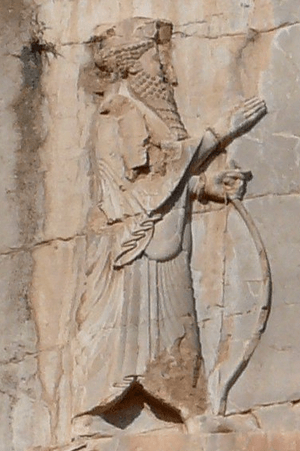Xerxes facts for kids
Quick facts for kids Xerxes I |
|
|---|---|
| King of Persia and Media Great King King of Kings King of Nations Pharaoh of Egypt |
|

Rock relief of Xerxes at his tomb in Naqsh-e Rustam
|
|
| King of Persia | |
| Reign | 486–465 BC |
| Coronation | October 486 BC |
| Predecessor | Darius I |
| Successor | Artaxerxes I |
| Born | 519 BC Persia |
| Died | August 465 BC (aged 53 or 54) Persia |
| Burial | Persia |
| Spouse | Amestris, (disputed: Vashti and Queen Esther) |
| Issue | Darius Hystaspes Artaxerxes I Arsames Amytis |
| Dynasty | Achaemenid |
| Father | Darius I |
| Mother | Atossa |
| Religion | Zoroastrianism |
Xerxes the Great was a powerful ruler, known as a Shah (which means king) of the Achaemenid Empire in Iran. He ruled from 486 to 465 BC. Xerxes was the son of Darius I and Atossa, who was the daughter of Cyrus the Great. When his father Darius passed away, Xerxes became the new Shah of Iran.
During his reign, Xerxes led a massive army against the Greek city-states. He famously defeated the brave Greek warriors at the Battle of Thermopylae. After this victory, his army took control of the city of Athens. However, the Greek warriors later achieved a major victory against Xerxes' navy at the Battle of Salamis in 480 BC.
Contents
Discovering Xerxes' Life and Reign
Xerxes I was a very important king in ancient history. His time as ruler saw many big events and changes. He inherited a vast empire and worked to keep it strong.
Becoming the King of Persia
Xerxes became king after his father, Darius I, died. He was chosen to rule over his older brothers. This was because his mother, Atossa, was the daughter of Cyrus the Great, a very respected founder of the empire.
- Xerxes took the throne in 486 BC.
- He spent his first few years as king dealing with rebellions.
- One major rebellion was in Egypt, which he quickly put down.
Leading the Persian Wars
Xerxes is most famous for his invasion of Greece. This was a continuation of the Persian Wars that his father had started.
- Xerxes gathered a huge army and navy from all parts of his empire.
- He built a special bridge of boats across the Hellespont (a narrow strait) to move his army into Europe.
- His goal was to conquer all of Greece and add it to the Persian Empire.
The Battle of Thermopylae
One of the most famous battles was at Thermopylae. Here, a small group of Greek soldiers, led by 300 Spartans, bravely fought against the massive Persian army.
- The Greeks held off the Persians for several days in a narrow pass.
- Eventually, the Persians found a way around the pass and defeated the Greeks.
- This battle showed the courage of the Greek defenders.
Taking Athens and the Battle of Salamis
After Thermopylae, Xerxes' army marched south and captured Athens. However, the Greeks had evacuated the city.
- The Persian navy then faced the Greek navy in the narrow waters near the island of Salamis.
- The smaller, more agile Greek ships were able to outmaneuver the larger Persian fleet.
- The Greeks won a decisive victory at the Battle of Salamis, which was a turning point in the war.
Xerxes' Later Years and Legacy
After the defeat at Salamis, Xerxes returned to Persia. He left some of his army in Greece, but they were later defeated.
- Xerxes focused on building projects in his capital city, Persepolis.
- He continued to rule his vast empire for many more years.
- Xerxes was assassinated in 465 BC, and his son Artaxerxes I became the next king.
Xerxes in Popular Culture
The story of Xerxes and the Battle of Thermopylae has inspired many modern works.
- The movie 300 is based on the events at Thermopylae and features Xerxes as a main character.
See also
 In Spanish: Xerxes para niños
In Spanish: Xerxes para niños

